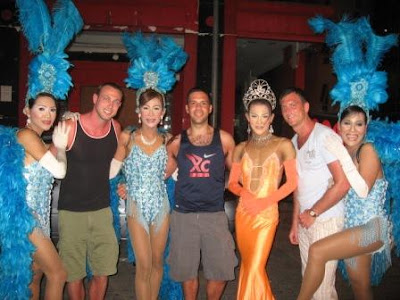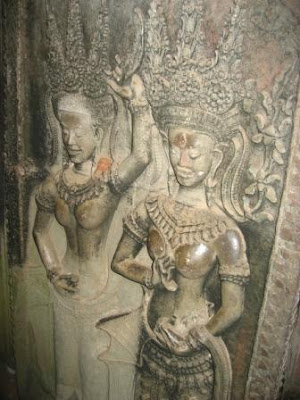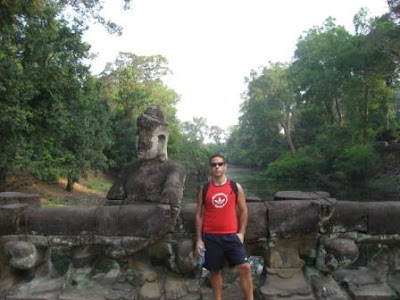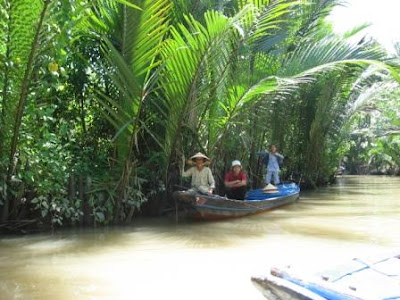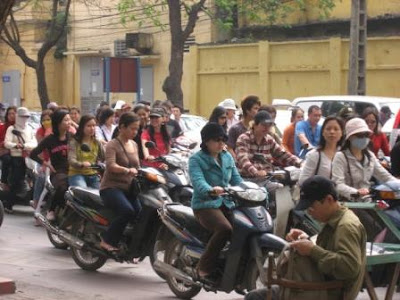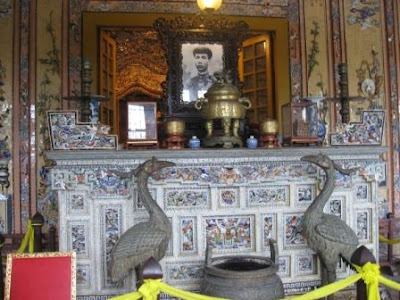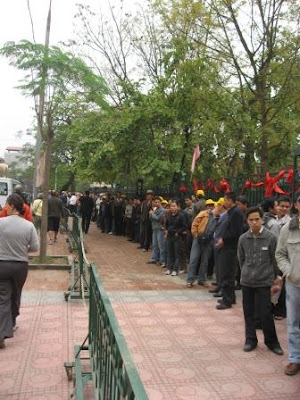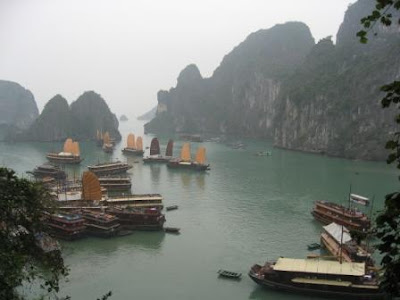24 Days in Southeast Asia: Thailand, Cambodia and Viet Nam
Chris, Joe & I flew out of NYC on March 1st on Thai Airways, destined for Bangkok. The most direct route took us over the North Pole, and and 17 hours later we were there, except for our ankles, which arrived a bit later.
March 2
Bangkok is very cool. It's hot, humid, bustling and, despite being overrun with tourists, has a lot of personality. Scyscrapers, many half-finished from the financial crisis of the late '90s, and hot pink taxi cabs abound. Because it's so warm, one of the nicest ways to get around Bangkok is a Tuk Tuk, a brightly decorated, three-person bench with wheels pulled by a two-stroke motorcycle. They're smaller than cars, so they weave through traffic more easily.
A Tuk Tuk ride in Bangkok
Despite being somewhat tired, after checking in we immediately showered and went out for dinner and drinks. As is common in Thailand, the cab driver did not take us to the restaurant we told him but an entirely different one from whom he received some type of kickback, though we were none the wiser until we reread the review in our guide several days later. From there we went to the gay area of Bangkok, the center of which seemed to be Silom Road. The narrow streets are full of gay bars, many of which are full of aged, unattractive white men out for the so-called skin trade, and just as many others geared toward ordinary Thais.
At the Telephone Bar on Silom Soi 4
From there we went a few streets over to one of Bangkok's notorious sex shows. Before the show was another spectacle, which was a rotating line of boys one the bar, displaying themsleves for would-be customers. The show that followed was somewhat tame, whereas other shows include live sex and more. Unfortunately, we did not get to see any of the lady shows which, according to one traveler I met, do include the infamous popping out of ping pong balls and even mixing of cocktails, all using tools Mother Nature provided. Breaking the rules, I snapped a few shots of a ridiculous but entertaining number we saw, which included wax-melting and leather outfits.
March 3
The next day we took it easy, got massages (excellent massages are available throughout Thailand for between six and ten USD per hour) and laid by the pool. The bars that Saturday were closed because of Makha Bucha day, one of three major holidays for Thai Buddhists, during which alcohol cannot be sold. In celebration, almost everyone in Thailand was wearing yellow most of the time we were there. For dinner, we met up with our friend Camelia at the place we intended to go the night before. Then, very tired from the sun and jetlag, we went back to the hotel and to bed.
March 4
The next morning we headed out by Metro to the Chatuchak Weekend Market, also called the JJ Market. By itself it is a small city filled with long rows of stalls, selling everything from cabbage to vintage movie posters to silk, and much more.
Amazingly, all of these candies are made from peanuts
That afternoon we visited the Temple Mount, which is part of the Wat Saket Temple. It is filled with shrines to the Buddha and temples.
From there we went to the Grand Palace. You can't get in with shorts or exposed shoulders, so I donned this lovely ensemble taken on loan from the visitors office. It was hot as hell without it, so by the time we left I was drenched.
The Grand Palace is saturated with beautiful temples, statues, shrines, wall painting and literally tons of gold.
On the way back to the hotel we stopped through another smaller market. I swear you can find anything you want if you look long enough at the markets in Thailand. We also stopped and had some street food, reputed to be the best place to sample Thai cuisine and, from the looks of it, where most Thais take their meals.
It was very spicy
March 5 & 6
The next morning we fly to Phuket for several days in the sun. I had a paradise-like image of Phuket before going, but the area we stayed in -- Patong Bay -- was the trashiest beach town I've ever seen. We stayed there because all of the gay life is there, but other areas of the island and, based on what I heard, other islands nearby are calmer, cleaner and more picturesque.
To my surprise, 7 Eleven has a stronghold on the Thai convenience store market. They are everywhere!
Here is a funny ladyboy working the gay beach with her sarongs. Attitudes about gender identity in Thailand are incredibly laissez-faire; no one bats an eyelash, and you often cannot tell whether someone is a girl or a boy. It was very refreshing and entertaining.
At night, all of the gay bars are located inside a complex surrounding the Paradise Hotel. It's a fairly laid-back but enjoyable scene.
March 7
The next day I flew back to Bangkok for a connection through to Siem Reap, Cambodia, to meet up with Camelia. Siem Reap is the gateway to Angkor, the site of a series of capital cities built for the Khmer empire. There are many sites to visit there, some of the most notable of which are Angkor Wat and Bayon City. The size and remoteness of the structures is deserving of the word amazing. I had heard before and during the trip that they were one of so-called Seven Wonders of the World, but based on my Internet research that appears to be false. The whole area is a photgrapher's dream, both for the architectural beauty and the way the changing light makes every picture unique.
March 8
We hired a Tuk Tuk driver named Mr. Lai, and left from our hotel before dawn to see Angkor Wat, as is recommeded to enjoy the light of sunrise setting off the structure's silhouette. We then spent a good hour in the daylight, walking though through, up and down and around the enormous temple.
We ten moved onto Bayon City, which is a baroque style temple with bas-relief faces. It was built much later than Angkor Wat, and is equally impressive.
We moved on to see several other temples, which were all beautiful. Elephants, lions and multi-headed snakes seemed to be common themes throughout. Here are some other pictures of the other sites we visited.
A modern day recreation shows the multi-headed snake in better detail
For dinner we had a great meal, some cocktails and good conversation at the Dead Fish restaurant, where every ten minutes they do a short show of Apsara dancing, which is traditional Cambodian dancing that draws its themes heavily from agricultural life. The baskets shown below were used a coquettish back-and-forth between the boy and the girl.
March 9
The next morning, we hired Mr. Lai again to take us for an elephant ride. They're such intelligent and adorable animals. We got to feed them little bananas afterwards.
After saying good-bye to the elephants, we stopped at a site containing a memorial to the many Cambodians killed by the Khmer Rouge under the leadership of Pol Pot. It is estimated that he killed 25% of the population, included most of the educated people. The bigger and better known Tuol Sleng interrogation and torture center in the capital, Phnom Penh, recently opened as a museum.
From there we headed to a floating village near Siem Reap. The "village" consists of a bunch of floting structures, which include many homes, a police station, amusement park and a restaurant, which has a crocodile farm attached to attract tourists. The local residents use boats to travel from structure to structure. Living in this way seems rather clever when you see that the homes on land are all built on tall stilts to stay above water during th rainy season. Our boat driver told us that that area was split into Vietnamese and Cambodian communities, but we couldn't tell the difference.
After having lunch and relaxing we were picked up again in the afternoon to visit a tethered helium baloon from which you can get an aerial view of Angkor Wat and areas nearby.
The Tethered Baloon ride and view of Angkor Wat from above
March 10
The next day, Camelia and I took it easy and laid by the pool during the day. In the evening, we caught a flight to Saigon, aka Ho Chi Minh City, to rendez-vous with our classmates for what Georgetown MBA calls the Global Integrative Experience. It is a mini-consulting project that students perform for companies, located this year in South Africa, Czech Republic, Brazil, Dubai or Viet Nam. This was the reason we came to Asia in the first place. Our client was state-owned Vietcom Bank, the country's largest financial institution.
After having dinner, Chris, Joe and I went for a cocktail at the Park Hyatt, whose bar is reputed to be gay-friendly. From there we checked out a bar we had read about called Sam (Samsara). Most of what I can remember is that it was hot as hell inside, but it was interesting to get a glimpse of how the Vietnamese socialize. We moved quickly to another bar, Apocalypse Now (can't make sense of that name choice), before retiring for the night. This was the first and last attempt to experience gay Vietnam. Despite the raving reviews we had read, Vietnam's gay scene is still in its infancy.
March 11
The first thing you notice about Viet Nam when you get there is how atrocious the traffic is. Vietnamese roads are the most chaotic I've ever seen. Scooters cover the pavement, and they along along with the cars engage in a unqiue brand of merging and improvised yielding. Almost no one stops at traffic lights, and quite a few even drive against traffic. The most troubling part about it is that no one wears helmets; I saw two collisions while I was there, though luckily no one was seriously injured.
A tame example of Saigonese roadways in action
A view of the river and some of the city from our hotel
The next thing you notice about Viet Nam is how quickly things move. The country has been experiencing rapid growth of the past several years. there were even Gucci and Roberto Cavalli shops opening up near our hotel.
Our first day was spent touring the Mekong Delta, care of Georgetown. We drove for about two hours by bus to a boat, which took us to several islands. First, we had some local fruit and enjoyed a short concert of traditional music.
Then, we visited a coconut candy operation, and bought some of the warm, chewy candies at the end of assembly line. They also sold another Vietnamese specialty, snake wine!
Then, we took a short trail to see some of the island's flora, before arriving at a canal that took us back to the main waterway by rowboat. The leaf shown below is the one used to make the typical Vietnamese hat, also pictured.
One the way back to the bus, our tour guide expressed an uncomfortable liking for me, and egged my class on into chanting my name so that I would sing a song on the boat's microphone. It was mortifying. We then had a mediocre lunch of catfish before returning to the hotel.
March 12
The next day we had a tour of a local plant. We got the short end of the stick and were sent to Cargill's animal feed manufacturing facility over the local Nike factory.
In the afternoon I went with my classmate and friend Rob to Vinh's Tailoring to be fitted for customer-made suits. To get there from the hotel we took a cyclo, a Vietnames version of the Tuk Tuk which is powered by a bicycle. The suits cost about USD200 each, so I bought some work clothes while the getting was good.
March 13
The next morning we had a presentation from Intel, which is building factory in Vietnam. The American Consulate in Saigon also spoke about Viet Nam's political and economic position today, which was very interesting.
In the afternoon, I went to the War Remnants Museum, which treats Chinese and American conflicts in Viet Nam. It honors journalists' role, but aims more as bringing attention to the atrocities of war in Vietnam, mostly through pictures. A considerable section was devoted to the victims of dioxin, the agent in napalm. They also have a bunch of American war equipment, aircraft, etc. captured during the Viet Nam War. Many people I know criticized it as weak, propagandistic and overly one-sided, though I didn't share that opinion entirely. It was moving at times, and served as a gentle reminder of the intransigence of factions involved in idealistic wars and of the unintended consequences of those wars, the innocent bystanders.
In the evening, we presented a case to a class of Vietnamese economics and business students, and before bed had a few drinks at the Rex Hotel, a well-know spot in Saigon's District 1.
March 14
On Wednesday, we took a two-hour flight to Ha Noi, where Vietcom Bank's headquarters are located. Ha Noi is just as busy as Saigon, but the streets are narrower and the weather is cloudier. The result is a damp, dingy and dirty city. The architecture there is more noticeably influenced by the French. The whole city centers around Hoan Kiem Lake, at the center of which sits the Ngoc Son Temple. We did some walking around that afternoon, had dinner at a nice restaurant and a beer near the lake, then to bed.
March 15
At nine o'clock we presented our findings to a fairly large audience at Vietcom Bank. They were gracious hosts, and invited us to lunch afterwards.
In the afternoon, we attended a water puppet show at the Thang Long Water puppet Theatre, walked around a bit more and passed by the Ha Noi Opera, which was modeled after the Paris opera House. Then, we headed back to Saigon after a quick meal.
The puppeteers use levers behind a grass curtain
March 16
On last day of the Georgetown-run program in Viet Nam, we visited the Dieu Giac Orphanage, run by several loving buddhist nuns. It was hands-down the highlight of my time in Viet Nam. The children were so adorable and well-behaved, and seemed so much to enjoy our visit and playing with our cameras. The conditions there were not terrible, though the children work with practically nothing. The orphanage is badly in need of more resources for feeding the children and hiring teachers and others to give the kids more personal attention. For those reading this who wish to make a donation to the orphanage, you may contact the nuns by e-mail at dieugiac.vn@hcm.fpt.vn to obtain the necessary money transfer information.
March 17
The next morning we flew to Hue, the imperial capital of Viet Nam's Nguyen Dynasty from 1802 to 1945. It is located smack in the middle of the country. We spent that day touring the Citadel there, which includes many temples and gardens.




March 18
The next day we took a boat tour up the Huong River to see many pagodas, temples and tombs belonging to several of Viet Nam's emperors.







That night we went to an art gallery and bought some very lovely silk embroidery paintings.

Later on, we flew north to Ha Noi. We checked into the one of the biggest flewabag hostels I think I've ever stayed in. Here is a picture of Chris looking very frightened.
March 19
The next morning we waited in long lines to visit the tomb of Ho Chi Minh, surely vietnam's most revered leader. His body is preserved in a climate controlled room that has more security than Fort Knox. It was anticlimactic, to be sure. 

That afternoon, we changed hotels, ran some errands and booked a two-day tour of Ha Long Bay for the following morning.
March 20
Ha Long Bay is a Unesco World Heritage Site. In it there are tons of tiny islands of stone created by water erosion. Basically, there are two types of rocks in the earth there, and one of them is more easily worn away than they other, creating a great site of natural beauty. The Vietnamese have a legend involving dragons and pearls that explains their existence. I forget the details. 



March 21
The next day we toured Cat Ba Island, Cat Ba National Park, a local bee farm and then spent the night in the town of Cat Ba.

March 22
We spent the following morning playing cards with a nice Danish couple on boat back to the bus which took us to Ha Noi to catch our flight home. We were so ready for a break from deep-fried spring rolls, processed pork products and uncomfortable beds.
It was an overdue end to a long trip, but I enjoyed it thoroughly.












































